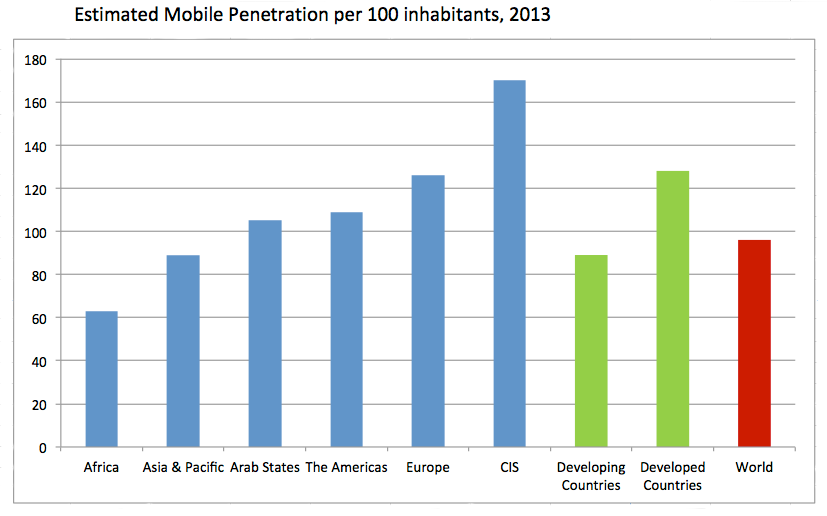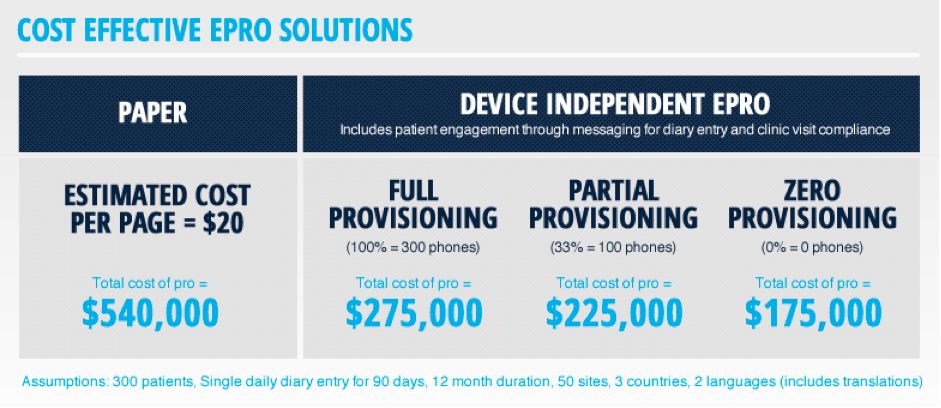Going Mobile: How Mobile Technology is Evolving in Clinical Trials
It is estimated that mobile penetration now stands at 96% globally.

It is estimated that mobile penetration now stands at 96% globally (see figure 1), with significant growth in subscriptions in the developing world in recent years, increasing from 69% of the population in 2011 to 89% in 2013.1,2 As access to devices expands across the globe, the use of mobile technology in all walks of life has become commonplace. As a result, mobile communication has been leveraged to provide information and access to services across multiple industries, from simple applications such as checking train timetables to mobile banking with secure access to personal information in a highly regulated industry. Clinical research is no exception to this trend and indeed the pharmaceutical industry has seen an increasing movement to leverage mobile technology to engage with patients and collect their data during clinical trials.

The evolution of mobile in clinical research
In many ways, the inclusion of mobile phones and other devices in the clinical arena has been an evolution. The first step began almost a decade ago with the use of short message service (SMS) messages to address the retention and compliance issues so commonly faced during research. The scale of the problem was accurately brought home in a recent article in the Drug Information Association’s (DIA) journal, Therapeutic Innovation & Regulatory Science, which revealed that as many as 30% of clinical trial participants do not take their study medication correctly.3 The main reasons cited for non-adherence include forgetfulness,4 poor communication with healthcare professionals,5 especially in remote locations, and absence of symptoms.6 An additional challenge for clinical trials is to retain patients for the duration of the trial and reduce the number of patients lost to follow-up. In its recent “Perceptions and Insights Study,” the Center for Information and Study on Clinical Research Participation (CISCRP) found that patients who drop out of clinical studies tend to be less self-motivated, less confident, less understanding of the process, and less satisfied that their questions have been answered.7
Mobile technology provided a means for researchers to communicate with patients remotely between site visits through a medium that patients carried with them wherever they were. It provided an effective system for sending reminders to ensure timely actions such as clinic visit attendance, fasting, correct medication intake etc., while also establishing the means to communicate much more broadly with the patient, serving as a two-way open communication channel that allowed patients to respond to prompts as appropriate. This was the first step towards mobile electronic patient reported outcome (ePRO) collection.
The introduction of these “retention and compliance” services enabled research sponsors to monitor safety, manage compliance. and ensure patient retention throughout the study period. For example, in a cardiovascular outcome event monitoring study, a mobile communication service was included to help maintain contact with patients between subject visits, with a view to increasing the likelihood of the patient reporting if and when an event occurred. The use of this mobile service resulted in a 5% increase in visit compliance and a 4.5% reduction in early patient withdrawal compared to those not using the service. Moreover, in a study of 13,000 patients, it was estimated that if used across the entire study, this would have equated to a four-month earlier finish, resulting in the pharmaceutical sponsor saving over $14 million in costs.8
The rise of mobile ePRO solutions
The rise of mobile ePRO tools, particularly those implemented through everyday mobile technology, has transformed the way patients engage in clinical trials. The ability to provide familiar technology to patient populations facilitates the collection of time-stamped data and as mobile technology has propagated across the globe, it serves as an ideal mechanism for communicating and collecting data from hard-to-reach patients in developing markets such as Eastern Europe, Asia Pacific, and Latin America.
With patient compliance rates typically as low as 55%,9 it is important to ensure the simplicity of the data collection interface. ePRO solutions can provide a simple, familiar, and effective modality to communicate and collect data and information from patients. As users are already familiar with the technology, they can navigate familiarly through the different steps of the data-collection process. As a result, these tools facilitate simple, real-time, and reliable collection of data from study participants, regardless of age or demographic.
Mobile ePRO solutions can be customized to suit the specific requirements of each trial. The assessment could be a series of text messages sent intermittently to a patient’s mobile phone to deliver online questionnaires, which can then be answered instantly via the mobile device. Alternatively, assessments can be delivered via an app—a route which is particularly useful when patients are in regions likely to have limited connectivity; Data can be stored within the app and transmitted when connection is available. The use of an app also enables automated connection to medical devices such as blood glucose meters and spirometers via Bluetooth connections.
Mobile also allows for the inclusion of validated instruments in PRO. To achieve this, the author must approve the use of the scale in question; this is typically achieved through a usability study to ensure patients can interact with the electronic version and a validation study to assess equivalence compared to existing modes of delivery. An example of such a study is the m-WOMAC Osteoarthritis Index, which was found to be valid and reliable using a simple mobile phone internet connection, showing no difference between mobile and paper scores.10
Introducing BYOD into clinical research
The traditional model for collecting ePRO measures has been to provision devices, seeking the assurance of fixed parameters for data viewing and validation. Until recently, this option has been fairly restrictive, providing a single device to all populations across each study, regardless of their familiarity with the technology. However, advances in technology have enabled the onset of a “bring your own device” (BYOD) approach through the ability to recognize device parameters and optimize the configuration of data according to the device in use (e.g., laptop, tablet, mobile phone).
The growth of digital and mobile technology means that many patients already own a device that can be used during the study. Device analysis can easily be integrated into patient enrollment and device provisioning can typically be reduced to as little as 10% or 20% of study participants (see case study below). In some cases, this approach will remove the need for provisioning altogether such that the participants’ own devices are employed throughout the study.
A BYOD approach delivers an extremely cost-effective strategy to engage patients through sharing information and capturing data on their own devices. The requirement to provide devices is significantly reduced, or even removed altogether, as is the logistical challenge of managing large quantities of devices across the globe. An illustration of the cost savings that can be achieved is shown in figure 2.

The first step towards BYOD was taken in late phase trials, where collecting real-world evidence from diverse populations is often especially challenging. Unlike the small populations that are closely managed by clinical trial sites in pre-approval clinical research, late phase studies require management of large, diverse populations by physicians and health care professionals (HCPs) over long periods of time with fewer “touchpoints.” As a result, providing patients with hardware for electronic data capture (EDC) has historically been cost-prohibitive, so trials began to include online self-reporting as an alternative to paper data capture.11 It is now possible to extend this BYOD opportunity through platforms designed to capture data securely from any connected device. Through recognizing the device being used and optimizing the content accordingly, identifying personally identifiable information (PII), and having internal procedures in place to secure this PII, a BYOD approach can be used with confidence as part of an efficient clinical strategy.
While there are existing examples of pre-approval BYOD use, such as the Phase III vaccine study case study below, the final stage in the evolution of mobile in clinical trials will be the broad use of a BYOD approach in Phase II and III studies. This is currently a hot topic for discussion across the industry.12,13,14,15 Existing evidence supports scale equivalence across multiple modalities, such as the PROMIS study using interactive voice response, paper, personal digital assistant, and computer,16 and the ability to identify exact specifications of devices in use (screen size, operating system) and to block their usage if they fall outside of the validation range. It is expected that studies providing evidence to support use of BYOD for validated measures will be published in the near future and increasing numbers of BYOD pre-approval studies are set to be announced during 2014.
Reshaping the industry
Assessing the current landscape of the pharmaceutical industry, it is evident that mobile technology has a large role to play in improving the quality, simplicity, and ease of use of ePRO across the clinical-to-real-world continuum. The opportunities mobile solutions hold for the industry are vast, with the potential to reduce the major financial burdens as a result of increasing pressure to accelerate the path of drug candidates through clinical trials. In late-phase and real-world studies, especially, where adherence is often a major issue, mobile solutions provide an opportunity to incorporate patient engagement features to increase adherence and, as a result, collect more accurate, unbiased data.
Mobile technology is increasingly being implemented as a means of communicating directly with patients across broad demographics and multiple locations in both clinical studies and healthcare programs. The familiarity and universal nature of mobile devices and the ability to select the right tool according to the type of study that is being conducted, region, and demographic, makes the technology well-placed for integration into global markets. With a variety of industry reports and figures now advocating the use of digital technology in the healthcare industry, sponsors, CROs, and global health organizations are actively searching for opportunities to incorporate mobile solutions into their health programs.
Case study – BYOD in a vaccine surveillance study
Study overview: A Phase III, observer-blind, randomized, multi-country, non-influenza vaccine comparator-controlled study to demonstrate the efficacy of an influenza candidate vaccine administered intramuscularly in 3,150 healthy children 6 months to 35 months of age across multiple countries in Europe.
The primary endpoint for the study was the efficacy of vaccine in the prevention of RT-PCR confirmed influenza A and/or B disease for any seasonal influenza strain, when compared to non-influenza control vaccines.
Data capture solution: The use of a BYOD approach offered parents the flexibility to use their preferred means of contact for completing diary entries. Eighty-five percent of parents opted to use their own mobile phone or personal computer, thus vastly reducing provisioning requirements for the study.
eDiary option
Subject Selection
Use of own mobile phone
68.1%
PC / Laptop Browser
16.1%
Total
84.2%
Provisioned mobile phone
15.8%
Results: The use of EDC provided greater resource efficiency and timelier follow-ups for the research team, as the switch from weekly to daily contact was symptom driven, and, therefore, management would have been immensely complicated and resource-intensive using paper.
Given the scale and geographic spread of the study, 100% provisioning would have been cost-prohibitive, both in terms of purchase of devices, as well as the associated logistics, maintenance, and support necessary.
With 85% of parents/guardians using their own device (PC, laptop, mobile), the BYOD enabled a data capture method that would not previously have been possible. Parents/guardians benefitted from a user-friendly interface (with automated decision-making via branching logic in the eDiary) and being able to contribute from the familiarity of their own device (minimizing end-user training). They were able to easily complete assessments and report outcomes throughout the study in the simplest possible way. This empowered parents/guardians to steer their participation and ultimately improve their child’s health. It also enabled high levels of data entry compliance.
Considering that the average provisioning cost per device (including setup, monthly data charge, and monthly lease) was $400, the savings are clear to see. As the study draws to a close following the second flu season, savings are expected to total almost $3 million upon completion.
Tim Davis is CEO and co-founder of Exco InTouch.
References
- International Telecommunication Union, “ICT Facts and Figures: The World in 2013,” http://www.itu.int/en/ITU-D/Statistics/Pages/facts/default.aspx
- International Telecommunication Union, “ICT Facts and Figures: The World in 2011,” http://www.itu.int/ITU-D/ict/facts/2011/material/ICTFactsFigures2011.pdf
- D.L. Smith, “Patient Nonadherence in Clinical Trials: Could There Be a Link to Postmarketing Patient Safety?,” (2012), Therapeutic Innovation & Regulatory Science.
- L.R. Martin, et al., “The Challenge of Patient Adherence,”(2005), The Clinical Risk Manager
- G.A. Hamilton, “Measuring Adherence in a Hypertension Clinical Trial,” (2002), European Journal of Cardiovascular Nursing.
- E. Vermeire, et al., “Patient Adherence to Treatment: Three Decades of Research. A Comprehensive Review,” (2001), Journal of Clinical Pharmacy and Therapeutics.
- The 2013 CISCRP Perceptions & Insights Study, “Report on Ineligible Participants and Those Who Terminate Participation Early,” (2013), http://www.ciscrp.org/professional/reports/
- Exco InTouch Internal Data.
- H.B. Bosworth, “ Patient Treatment Adherence: Concepts, Interventions and Measurement,” (2005), Routledge.
- N. Bellamy, et al., “Osteoarthritis Index Delivered By Mobile Phone (m-WOMAC) is valid, reliable, and responsive,” (2011), Journal of Clinical Epidemiology, 64(2) pp182-190.
- P. Wicks, et al., “Accelerated Clinical Discovery Using Self-Reported Patient Data Collected Online and a Patient-Matching Algorithm,” (2011), Nature Biotechnology, 29 pp411-414.
- http://www.mct-congress.co.uk/pane/programme/
- Can BYOD and Smartphones Move Clinical Trials Forward? http://www.cio.com/article/736096/Can_BYOD_and_Smartphones_Move_Clinical_Trials_Forward_
- Device Independence is the Future of Clinical Trials. http://www.appliedclinicaltrialsonline.com/appliedclinicaltrials/Trial+Design+Articles/Device-Independence-is-the-Future-of-Clinical-Tria/ArticleStandard/Article/detail/828040
- “Electronic Clinical Outcome Assessments: Coming to a Device Near You!” DIA Annual Meeting 2014, advertised program at http://www.diahome.org/en-GB/Flagship-Meetings/DIA2014/Meeting-Program/Find-Sessions-and-Presentations.aspx
- J.B. Bjorner, et al., “Method of Administration of PROMIS Scales Did Not Significantly Impact Score Level, Reliability, or Validity,” (2014), Journal of Clinical Epidemiology, 67(1) pp108-113.
Improving Relationships and Diversifying the Site Selection Process
April 17th 2025In this episode of the Applied Clinical Trials Podcast, Liz Beatty, co-founder and chief strategy officer, Inato, discusses a number of topics around site engagement including community-based sites, the role of technology in improving site/sponsor relationships, how increased operational costs are impacting the industry, and more.
Behind the Buzz: Why Clinical Research Leaders Flock to SCOPE Summit
February 7th 2025In this episode, we meet with Micah Lieberman, Executive Conference Director for SCOPE Summit (Summit for Clinical Ops Executives) at Cambridge Innovation Institute. We will dive deep into the critical role of collaboration within the clinical research ecosystem. How do we bring together diverse stakeholders—sponsors, CROs, clinical trial tech innovators, suppliers, patients, sites, advocacy organizations, investors, and non-profits—to share best practices in trial design, program planning, innovation, and clinical operations? We’ll explore why it’s vital for thought leaders to step beyond their own organizations and learn from others, exchanging ideas that drive advancements in clinical research. Additionally, we’ll discuss the pivotal role of scientific conferences like SCOPE Summit in fostering these essential connections and collaborations, helping shape the future of clinical trials. Join us as we uncover how collective wisdom and cross-industry partnerships are transforming the landscape of clinical research.
FDA-Approved Gene Therapy Beqvez Shows Sustained Efficacy, Safety in Long-Term Hemophilia B Trial
April 17th 2025Beqvez (fidanacogene elaparvovec), an FDA-approved one-time gene therapy for hemophilia B, demonstrated sustained factor IX expression, low bleeding rates, and a favorable safety profile over long-term follow-up.